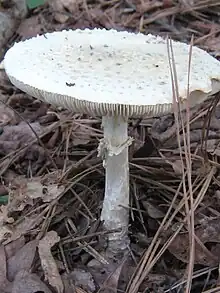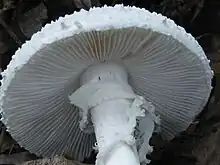| Amanita cokeri | |
|---|---|
 | |
| Scientific classification | |
| Domain: | Eukaryota |
| Kingdom: | Fungi |
| Division: | Basidiomycota |
| Class: | Agaricomycetes |
| Order: | Agaricales |
| Family: | Amanitaceae |
| Genus: | Amanita |
| Species: | A. cokeri |
| Binomial name | |
| Amanita cokeri (E.-J.Gilbert & Kühner) E.-J.Gilbert | |
| Synonyms[1] | |
|
Lepidella cokeri E.-J.Gilbert & Kühner (1928) | |
| Amanita cokeri | |
|---|---|
| Gills on hymenium | |
| Cap is convex | |
| Hymenium is free | |
| Stipe has a ring and volva | |
| Spore print is white | |
| Ecology is mycorrhizal | |
| Edibility is poisonous | |
Amanita cokeri, commonly known as Coker's amanita[2] and solitary lepidella,[3] is a poisonous mushroom in the family Amanitaceae.[4] First described as Lepidella cokeri in 1928, it was transferred to the genus Amanita in 1940.
Taxonomy
Amanita cokeri was first described as Lepidella cokeri by mycologists E.-J.Gilbert and Robert Kühner in 1928. It was in 1940 when the species was transferred from genus Lepidella to Amanita by Gilbert.[1] Presently, A. cokeri is placed under genus Amanita and section Roanokenses. The epithet cokeri is in honour of American mycologist and botanist William Chambers Coker.[5][6]
Description

Its cap is white in colour, and 7–15 centimetres (3–6 inches) across. It is oval to convex in shape. The surface is dry but sticky when wet. The cap surface is characterized by large pointed warts, white to brown in colour.[7]
Gills are closely spaced and free from the stem. They are cream at first, but can turn white as the mushroom matures. Short-gills are frequent. Stem is white, measuring 10–20 cm (4–8 in) long and 1–2 cm (1⁄2–3⁄4 in) thick. It tapers slightly to the top, smooth to shaggy in texture. There is a ring, thick and often double-edged, the underside being tissuelike. The universal veil hangs from the top of the stipe.[8] The basal bulb is considerably large in size, with concentric circles of down-turned scales. The volval remnants stick to it and cause irregular patches.[8]
Spores are white, elliptical and amyloid. They measure 11–14 x 6–9 μm, and feel smooth. Flesh is white, and shows no change when exposed. There is no distinctive odour,[3][7] but some specimens may develop the smell of decaying protein.[9]
Similar species
Amanita solitaria is a closely related species, though a completely different European taxa.[10] The notable similarity is that both it and A. cokeri are double-ringed.[11] A. timida, from the tropical South Asia, resembles A. cokeri in its volval structure, thick and notable ring and the large bulbal base.[12][13]
Distribution and habitat
A. cokeri inhabits mixed coniferous or deciduous woods and also grows on the ground. It grows mainly on oak and pine trees, and leaves a white deposit. It grows isolated or in groups.[14] It is mostly distributed in southeastern North America.[15] It fruits from July to November.[14]
Toxicity
In a study, the presence of non-protein amino acids 2-amino-3-cyclopropylbutanoic acid and 2-amino-5-chloro-4-pentenoic acid was revealed. The former acid was found to be toxic to the fungus Cercospora kikuchii, the arthropod Oncopeltus fasciatus and the bacteria Agrobacterium tumefaciens, Erwinia amylovora, and Xanthomonas campestris. The toxicity for bacteria could be eliminated by adding isoleucine to the medium. The other acid did not prove toxic.[16]
See also
References
- 1 2 "Amanita cokeri (E.-J. Gilbert & Kühner) E.-J. Gilbert". MycoBank. International Mycological Association. Retrieved 2011-03-01.
- ↑ "Standardized Common Names for Wild Species in Canada". National General Status Working Group. 2020.
- 1 2 McKnight, Kent H.; McKnight, Vera B. McKnight; illustrations by Vera B. (1987). A field guide to mushrooms, North America (2. ed.). Boston: Houghton Mifflin. p. 222. ISBN 0-395-42101-2.
- ↑ Miller Jr., Orson K.; Miller, Hope H. (2006). North American Mushrooms: A Field Guide to Edible and Inedible Fungi. Guilford, CN: FalconGuide. p. 46. ISBN 978-0-7627-3109-1.
- ↑ Roody, William C. (2003). Mushrooms of West Virginia and the Central Appalachians. Lexington: University Press of Kentucky. p. 50. ISBN 0-8131-9039-8.
- ↑ Bessette, A. E. (2007). Mushrooms of the southeastern United States (1 ed.). Syracuse: Syracuse Univ. Press. p. 106. ISBN 978-0-8156-3112-5.
- 1 2 Kuo M. (August 2003). "Amanita cokeri". MushroomExpert.com. Retrieved 2011-03-01.
- 1 2 Fergus, C. Leonard; Fergus, Charles (2003). Common edible and poisonous mushrooms of the northeast (1st ed.). Mechanicsburg: Stackpole Books. p. 22. ISBN 0-8117-2641-X.
- ↑ Tulloss, RE. "Amanita cokeri". Amanitaceae.org. Retrieved 24 October 2012.
- ↑ Fuller, Thomas C.; McClintock, Elizabeth (1986). Poisonous plants of California. Berkeley: University of California Press. p. 43. ISBN 0-520-05568-3.
- ↑ Tulloss, RE. "Amanita solitaria". Amanitaceae.org. Retrieved 24 October 2012.
- ↑ Bas, Cornelis (1969). Morphology and subdivision of Amanita and a monograph on its section Lepidella. p. 390.
- ↑ Tulloss, RE. "Amanita timida". Amanitaceae.org. Retrieved 24 October 2012.
- 1 2 Phillips, Roger. "Amanita cokeri". Rogers Mushrooms. Archived from the original on 6 November 2011. Retrieved 24 October 2012.
- ↑ Gibbons, Whit; Haynes, RR.; Thomas, JL.; with a foreword by Geller, Robert J. (1990). Poisonous plants and venomous animals of Alabama and adjoining states. Tuscaloosa: University of Alabama Press. p. 28. ISBN 0-8173-0442-8.
- ↑ Drehmel, Dennis C.; Chilton, William Scott (2002). "Characterization and toxicity of Amanita cokeri extract". Journal of Chemical Ecology. 28 (2): 333–41. doi:10.1023/A:1017986108720. ISSN 0098-0331. PMID 11925071. S2CID 7986407.
